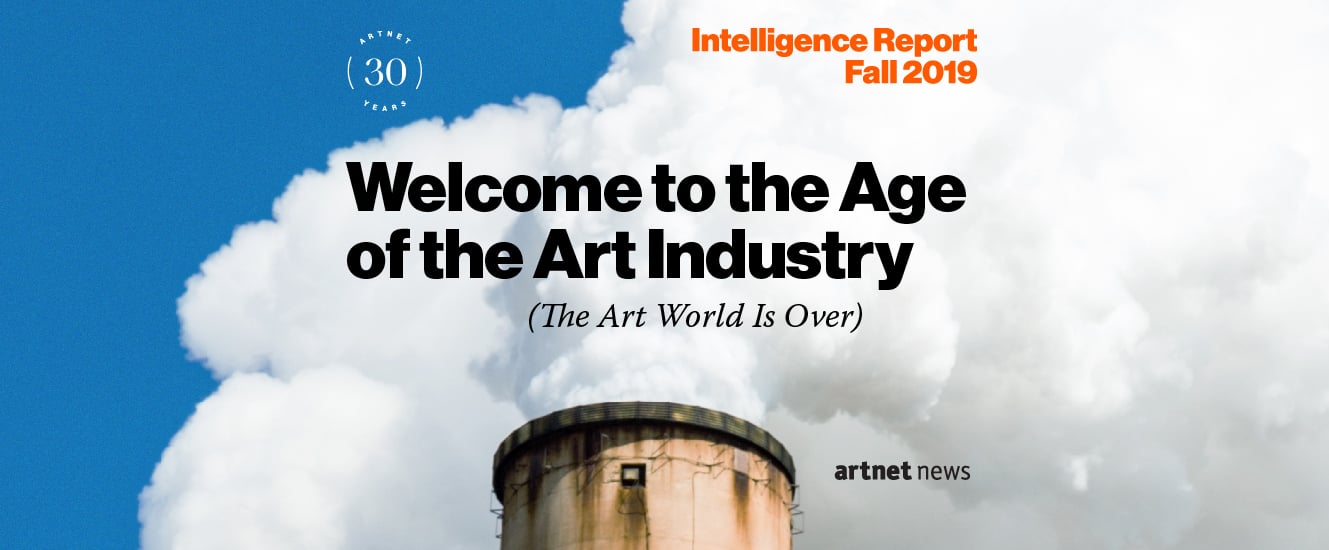
[Click here to download the full report]
As you might glean from the smokestacks on the cover, this fall 2019 edition of the artnet Intelligence Report advances a thesis: that over the past 30 years, the art world has evolved into an art industry. Once the modestly sized province of connoisseurs, passion-driven dealers, and hobbyist collectors, the art business today exists as an interconnected global network dominated by multibillion-dollar corporations and swashbuckling, profit-minded investors who care about numbers as much, if not more, than they care about the art itself.
From one point of view, this market is a strange, chimerical amalgam of the luxury industry, the financial sector, and a high-class casino; seen another way, it is a burgeoning engine of creativity and innovation that could yield a new Renaissance in art. As with art itself, the art market’s nature is in the eye of the beholder.
In this issue, we speak to a trio of collectors who touch on how the business side of things has changed over the past three decades—for better and for worse. We also dive deep into reams of data, which show that the market is now slowing, with key indices coming down from their recent peaks. This report outlines those areas of retrenchment in the marketplace and identifies where the alarm bells are ringing. It also shows where opportunities are developing, both through the data and via an in-depth survey of the increasingly exciting market for African contemporary art. As the current reshuffling continues, it is likely that the winners and losers with be spread unevenly around the globe, in ways that mirror broader macroeconomic trends.
Because this fall is artnet’s 30th anniversary, our report also takes a look at how the company’s pioneering Price Database shaped the art field and helped accelerate its headlong growth. We spoke to Hans Neuendorf, the founder of artnet, about the obstacles he and the company overcame as it became the first-ever art business to go online—and about his ambivalence regarding the impact that access to transparent pricing has had on the field he entered as an idealistic art dealer in the 1960s.
Today, 30 years into the history of artnet, and now in the midst of what looks like the beginnings of a market correction, it is clear that we remain in the infancy of the art industry—with all the positive and negative connotations that word, which conjures a smoke-belching factory, conveys. Where will things go? See you in 30 years.
[Click here to download the full report]
— TABLE OF CONTENTS —
– Marketplace
• Total auction sales around the globe
• Why the top of the market is shrinking
• Expert predictions for what’s ahead
– What I’m Buying & Why
Collectors dish on their latest obsessions and the works that got away
– The Best-Seller Lists
The top 10 lots of 2019 to date in every major category
– How the Art World Became (Sniff) the Art Industry by Tim Schneider
As artnet celebrates its 30th anniversary, we use data to tell the story of how the market has transformed—radically—over the past three decades
– Why the Golden Age of Auction Guarantees Is Probably Over by Eileen Kinsella
These lucrative hedges were once the financial instrument of choice for speculators and market manipulators, but now they’ve lost their luster
– Collecting Isn’t What It Used to Be: A Roundtable by Cristina Ruiz
Dimitri Daskalopoulos, Paul Ettlinger, and Patrizia Sandretto Re Rebaudengo discuss how the business of collecting has evolved since 1989
– Why Is Everyone Talking About the African Art Market? by Rebecca Anne Proctor
We break down the rising stars, most important players, and everything else you need to know about the buzzing scenes spread across six African cities
– How Hans Neuendorf Changed the Art Business by Andrew Goldstein
artnet’s founder recalls how he developed the first online auction database and reveals why he is torn about the sweeping changes it wrought
– Dive Into Some Refreshing Market Data by Julia Halperin
We pull together exclusive data about the market’s performance in 2019 to date, gathered from the artnet Price Database, and speak to experts about what it all means
– Who Are Today’s Most Bankable Artists?
See the 10 best-selling artists in each genre
— KEY FINDINGS —
- A grand total of $9.1 billion was spent on fine art, decorative art, and design at auction in the first half of 2019—down 13.5 percent from the equivalent period one year ago.
- Weakness at the top of the market is driving this slump: Total auction sales of works over $10 million dropped by 35 percent in the first six months of this year compared to the first half of 2018.
- Figuration has officially displaced abstraction as the most desirable style of new art. Not one of the top 10 works sold at auction by ultra-contemporary artists in the first half of this year was abstract.
- The Brooklyn-based artist KAWS outsold Jean-Michel Basquiat, the far more established graffiti artist-turned-market phenomenon. Work by KAWS generated $70.6 million at auction in the first six months of 2019, compared to Basquiat’s $65.6 million.
- The UK saw its auction sales plummet 24 percent in the first half of the year, while China only experienced a 10.5 percent dip, suggesting that the prospect of Brexit is having a more catastrophic effect on the market than the US-China trade war.
- The gap between Christie’s and Sotheby’s has narrowed for the first time in several years, with both auction houses posting just over $2 billion in sales in the first half of 2019.